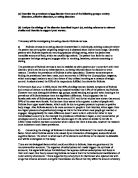This essay will be investigating the eating disorder Bulimia nervosa.
- Describe the prevalence of one disorder from one of the following groups: anxiety disorders, affective disorders, or eating disorders
(b) Analyse the etiology of the disorder described in part (a), making reference to relevant studies and theories to support your answer.
This essay will be investigating the eating disorder Bulimia nervosa.
a) Bulimia nervosa is an eating disorder characterised in individuals, as being a disorder where the patient has a strong fear of gaining weight and is obsessed about his/her body image. Generally patients with Bulimia experience recurring episodes of binge eating, where the patient eats incredible amounts of food, which are usually high calorie. The patient then feels the need to compensate the binge eating and engages either in vomiting, laxatives, extreme excerising or dieting.
The prevalence of Bulimia nervosa is hard to establish as often patients don’t come forth with their disorder, which can be due to embarrassment, not being informed about the disorder or other reasons. Therefore the prevalence of Bulimia is often speculation. However some attempts at finding the prevalence have been made, such as a survey in 1980 by the Cosmopolitan magazine, which encouraged readers to send them letters if they utilised vomiting as a measure of weight control. Analysis showed the 83% of the respondents fulfilled the criteria for Bulimia.
Furthermore Keel et al. in 2006, found that 40% of college women showed symptoms of Bulimia and a study of visitors to a family planning hospital revealed that 1.9% of the patients had Bulimia. However one must distinguish between age groups, social standing and gender when looking at the prevalence of Bulimia because there is a significant difference. Freud supposed that the female:male ratio of Bulimia patients lies at around 10:1 and further studies have shown that around 99% of the cases were female. Furthermore there seems to be a greater number of people with Bulimia from upper social classes, which could be due to a greater pressure to present a positive body image. Also Bulimia seems to be more common in people in their twenties, where again there is a higher pressure of a positive body image as this is the time where most people get married or engaged. Geographically the main difference doesn’t seem to lie in culture but rather in how industrialised a country is. For example the prevalence of bulimia in Japan, a very conservative yet developed country, is at around 5.79% for women aged 15-29, which is similar to the US. In LEDC’s less research has been conducted which means that there is less data, however the research done indicates a much lower prevalence.







